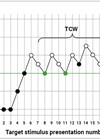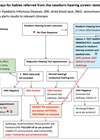Comparing studies requires common approaches. Ali Faramarzi takes a moment to consider how to tackle the presentation of audiometric data in publications.
Uniformity in reporting hearing outcomes is paramount for accurate evaluation and comparison of hearing-related research. Standardised guidelines are essential; without them, comparing data between studies becomes problematic. One widely accepted method is the 4-frequency pure-tone average (PTA), using frequencies of 0.5, 1, 2, and 3 kHz.
This approach was first recommended in the 1979 American Medical Association (AMA) guidelines for calculating hearing handicap [1]. Subsequently, the AMA’s chosen frequencies were incorporated into the 1995 [2–4] and 2012 [5] guidelines issued by the Hearing and Equilibrium Committee of the American Academy of Otolaryngology—Head and Neck Surgery (AAO-HNS). These guidelines for reporting hearing results are still recommended and used today.

Traditionally, the calculation of PTA has followed the guidelines set forth by renowned institutions such as the AMA and the AAO-HNS. These bodies initially proposed the simple arithmetic mean (SAM) as the method for calculating PTA [1]. However, considering the decibel (dB) scale’s inherent logarithmic structure [6], the SAM may not accurately represent PTA values. This understanding necessitates a critical re-evaluation of current practices, suggesting that a logarithmic mean might yield more accurate results than the SAM. For instance, on a logarithmic scale, the average of 10 and 30 dB is not 20 dB but approximately 27.03 dB. This proposed analytical shift, aligning with the dB scale’s inherent logarithmic nature, could potentially facilitate a more precise determination of PTA. The steps to achieve this are as follows:
1. Conversion to linear scale: This initial step involves converting each dB value to a linear scale using the formula: Plinear = 10(PdB/10). This conversion is vital given that dB is a logarithmic measure of sound intensity.
2. Arithmetic mean calculation: After conversion, the arithmetic mean of the linear scale values is calculated by summing all the converted values and then dividing by the count of the values.
3. Conversion back to dB scale: The final step is to convert the mean value back to the dB scale, which can be done using the formula: PdB = 10*Log10(Plinear).
In light of the proposed shift from the SAM to the logarithmic mean for calculating the PTA, it is pertinent to consider the World Health Organization’s (WHO) recent hearing-impairment grading system, as outlined in their research [7]. The WHO system, which is widely recognised and validated through studies of functional communication in older adults, uses a four-frequency PTA at frequencies of 0.5, 1, 2, and 4 kHz. This selection of frequencies is noteworthy, as it slightly diverges from the frequencies recommended by the AAO-HNS, which suggests using 0.5, 1, 2, and 3 kHz, with an alternative method to calculate the 3 kHz threshold by averaging 2 kHz and 4 kHz if the 3 kHz data is unavailable [8].
'While the WHO report does not explicitly mention the method of PTA calculation, it is inferred that the arithmetic mean calculation is utilised, aligning with traditional practices. This approach could be particularly relevant for the WHO’s grading system, which is crucial for international public health policies and research. The WHO-proposed hearing-impairment grading system categorises hearing loss into grades based on the 4fPTA in the better ear: (1) normal, ≤19.50 dB HL; (2) slight/mild, 19.51–34.5 dB HL; (3) moderate, 34.51–49.5 dB HL; (4) moderately severe, 49.51–64.5 dB HL; (5) severe, 64.51–80.5 dB HL; and (6) profound, ≥ 80.51 dB HL. Each grade reflects a progressive increase in hearing impairment and its potential impact on functional communication, underscoring the importance of precise and consistent PTA calculations for accurate grading and effective public health interventions.
The re-evaluation of hearing outcome reporting guidelines [1–5, 7] shows that the recommended PTA calculation formula is SAM, which might be inappropriate for a logarithmic measure such as the dB scale. This underlines the importance of accurate and appropriate reporting of PTAs, where such data plays a pivotal role in diagnostic and treatment decisions. For greater accuracy, a shift from the SAM to the logarithmic mean should be considered. While it is acknowledged that implementing new standards often requires a transition period, it is essential to recognise that the proposed calculation formula utilises data that are routinely collected, merely suggesting a different approach to calculating averages. Consequently, the transition period is expected to be relatively brief. Hence, there is a need for a thoughtful revision of the guidelines on reporting hearing outcomes. This modification, which is essential for the sake of accuracy, can be implemented effectively. By adapting to these changes, we can bring about improvements in the quality and consistency of data reporting in hearing healthcare, thereby enabling a more precise and meaningful comparison between studies.
References
1. Guide for the evaluation of hearing handicap. JAMA. 1979;241(19):2055–9.
2. Monsell E, Balkany T, Gates G, et al. Committee on Hearing and Equilibrium guidelines for the evaluation of hearing preservation in acoustic neuroma (vestibular schwannoma). Otolaryngol Head Neck Surg 1995;113(3):179–80.
3. Monsell EM, Balkany TA, Gates GA, et al. Committee on Hearing and Equilibrium guidelines for the diagnosis and evaluation of therapy in Meniere’s disease. American Academy of Otolaryngology—Head and Neck Foundation, Inc. Otolaryngol Head Neck Surg 1995;113(3):181–5.
4. Monsell E, Balkany T, Gates G, et al. Committee on Hearing and Equilibrium guidelines for the evaluation of results of treatment of conductive hearing loss. Otolaryngol Head Neck Surg 1995;113(3):186–7.
5. Gurgel RK, Jackler RK, Dobie RA, Popelka GR. A New Standardized Format for Reporting Hearing Outcome in Clinical Trials. Otolaryngol Head Neck Surg 2012;147(5):803–7.
6. Hood LJ, Berlin CI, Parkins CW. Measurement of sound. Otolaryngol Clin North Am 1991;24(2):233–51.
7. Humes LE. The World Health Organization’s hearing-impairment grading system: an evaluation for unaided communication in age-related hearing loss. Int J Audiol 2019;58(1):12‑20.
8. Gurgel RK, Popelka GR, Oghalai JS, et al. Is it valid to calculate the 3-kilohertz threshold by averaging 2 and 4 kilohertz? Otolaryngol Head Neck Surg 2012;147(1):102–4.








